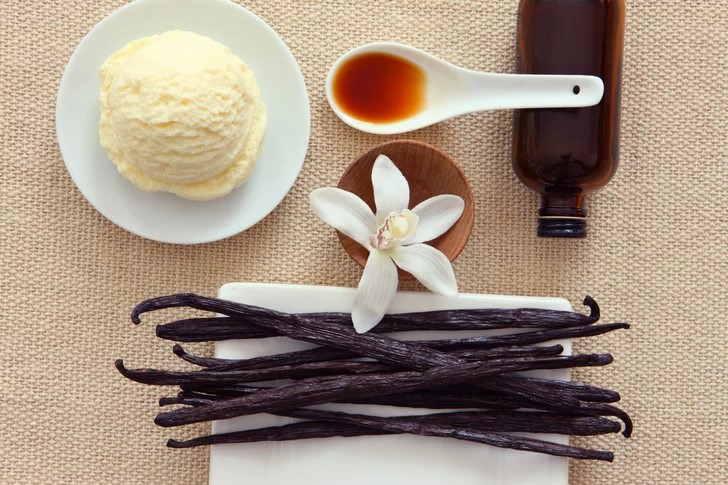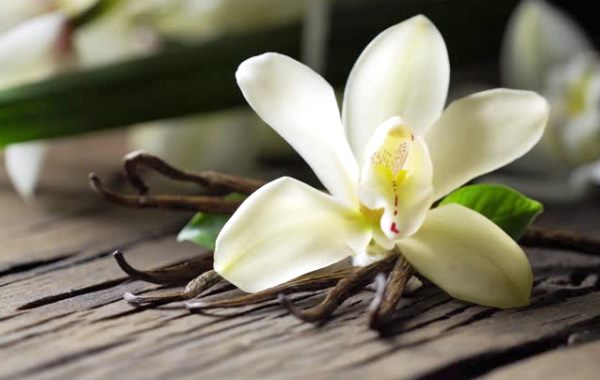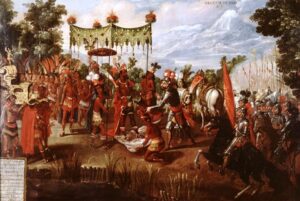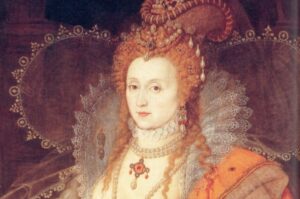Vanilla. We all know vanilla. Naturally warm and sweet, it’s the base note of dessert in the Western World, from the scoop of vanilla ice cream served with apple pie in the US to the warm custard poured over crumbles in the UK or baked into tarts by the Portuguese.
It’s that essential ingredient in cookies and cakes and puddings. It takes the edge off chocolate and coffee, and lifts a mug of hot milk to dreamy bedtime heights. One might even say that vanilla is the umami of the sweet palate.

Vanilla’s Bad Rep?
But vanilla gets a very bad rap these days. There’s a perception in this day and age that vanilla is somehow boring. In our quest for ever more exotic flavours of ice cream we’ve derided the humble but pure pleasures of a well-made vanilla ice cream. Other spices like star anise and cardamom, lovely though they both are, have become so achingly hip that good old vanilla seems like a dull, almost matronly staple in comparison. Vanilla has to be dressed up as “French Vanilla” or ” Genuine Madagascar Vanilla” or “Vanilla Bean”. We’ve even-horror of horrors- begun to use the term “vanilla” to mean boring, unimaginative sex. It’s as if vanilla has become the Doris Day of spices.
And that’s not fair.
Because in truth vanilla is the headiest of spices, with a history as dark and rich as the chocolate whose bitterness vanilla has been tempering since the dawn of time. It’s a tale of explorers and apothecaries, of princesses, queens, and orphaned slave boys. And it’s a tale that’s largely about sex. Vanilla, you see, was venerated first for its sexual powers, and that’s even how it got the name we know it by today.
Vanilla: Where It All Began…Maybe
Now with all those labels claiming “Genuine Madagascar Vanilla Beans”, you might think that vanilla hails from that fragrant spice island of the Indian Ocean. But it doesn’t, and nor is vanilla a bean.

Instead the story of vanilla starts in the lush green jungles of Mexico’s Gulf Coast. Thousands upon thousands of years ago, an orchid was discovered; an orchid so delicate and rare that it bloomed for just one day a year and could not self-pollinate, but instead relied upon a single species of bee in order to procreate. The Totonac People, indigenous to the these sultry verdant valleys, were the first to discover this orchid, and its thin green fruits whose scent grew heady once the fruit had begun to ferment in the tropical heat.
The legend grew among these people that sometime in their distant past the Princess Xanath, daughter of a goddess, fell in love with a Totonac warrior. Forbidden by her father to marry him, Xanath nevertheless could not bear to be parted from her lover, so the star-crossed pair fled into the jungle. But Xanath’s father and the tribesmen gave chase, and when they caught them, Xanath and her lover were beheaded. Where their blood soaked into the ground, the vine of the orchid grew.
Or, you know… maybe not.
The History of Vanilla – One Invasion at a Time.
In time the land of the Totonacs was invaded by the mighty Aztecs, and the tribe was forced into slavery and subjugation. The Aztecs too fell in love with the intoxicating sweetness of the orchid fruit, which they called “Tlilxochitl”, or “black flower”, because of how the fruits looked when they fermented and darkened. They demanded the tlilxochitl in huge volumes as “tributes” from the Totonacs, and prized it not only as a mellowing partner for their beloved chocolatl, but mostly for its own value. For the Aztecs, like the Totonacs, believed it to be a potent aphrodisiac.
But however much their new-found tlilx0chitl may have aided them in the bedroom, it was of no help to the Aztecs in battle. The conquering Aztec Empire was about to be brought to its knees by an even more rapacious nation, and leading the charge would be an explorer with no small degree of priapic prowess himself.
It hadn’t taken the Spanish Empire long to capitalize on the discovery of the Americas in 1492. By 1519 they had colonized the Caribbean, and were ready to take on the Aztecs. Hernan Cortes, a 34 year old adventurer who made his way from Spain to Cuba trailing a string of romantic entanglements and disappointed women in his wake, defied the orders of the Governor of Cuba, and gathered men and ships for the expedition.

By November of 1519, Cortes had marched into Tenochtitlan, Capital of the Aztec Empire, where he was greeted by the Emperor Moctezuma as an emissary of a god, and quite possibly handed his first golden goblet of the frothy, spicy chocolatl drink. But emissary of a god or not, Cortes was not what one would call a good guest. He had already forged alliances with several local tribes, among them the poor beleaguered Totonacs, and it wasn’t long before Moctezuma was a prisoner in his own palace. By 1521, after fending off an attack from the still enraged Governor of Cuba, Cortes had crushed the Aztec Empire, and all its riches began sailing east back to Spain.
Vanilla Reaches The New World
That dark and bitter and yet sweet chocolatl drink was an instant hit with the Spanish nobility, and soon its popularity spread across the courts of Europe. The tlilchoxchitl was of course proving popular, not only as a necessary ingredient for the chocolatl, but also because the Spaniards had learned of its aphrodisiac properties from the Aztecs, and the Spaniards liked a good aphrodisiac as much as the next guy. In fact word of the new spice’s sexual prowess spread quickly across Europe, and it soon gained fame in other countries. One German doctor claimed to have cured hundreds of men of impotence with only the use of the new spice.
Now Tlilchoxchitl is not an easy name for a European to conjure with, and soon the Spanish had given the spice the name we know it by today, Vanilla, meaning “little sheath”. The word “vanilla” derives from the diminutive form of “vaina”, from the Latin “vagina”. History records that the Spaniards came up with this name because of how the vanilla pods looked once they had been split. It’s worth noting at this point that the word “orchid” is derived from the Ancient Greek word for “testicle”. So when both the flower and the spice gained their European names, whoever coined them had only one thing on their mind.
But if the new vanilla was extremely popular as a partner to chocolate, and even more popular as an aide de boudoir, still nobody had yet contemplated using it on its own, solely for flavoring. It would take an ambitious and innovative Englishman to bring to light the sensational taste of vanilla, and he would do so in the service of a virginal queen with a famously sweet tooth.

Suddenly Vanilla is Everywhere
Born in Essex around 1530, Hugh Morgan defied several scrapes with the law to become Principal Apothecary To The Household of Queen Elizabeth I in 1583. Morgan had a fascination with botany, and was constantly attempting to perfect methods of extracting the toxins from generally poisonous plants so they might be used for good. It was perhaps this keen eye for the extraction of individual aspects of a plant that came to his aid when faced with the task of coming up with new and exciting tastes and flavors to satisfy the Queen’s rather demanding palate.
Despite somewhat frosty relations with the Spanish Empire, the new chocolate drink was all the rage in the English court as well, and though history does not record why the job of creating new sweets fell to Morgan and not one of the Queen’s accomplished cooks, it does record that it was Morgan who first thought to try out the new vanilla pods on their own. He began by using the dried pods to flavor marchpane, the thick almond paste now known as marzipan. This proved to be an instant hit with the Queen. So much so, in fact, that various sources claim that in her later years Queen Elizabeth ate nothing but vanilla flavored food. And if Morgan thought he had a hit on his hands with the new vanilla-flavored marchpane, he had no idea he’d be changing culinary history when he introduced the spice to custard.
And Lo! Vanilla Custard Was Born
Custard was by no means a new fangled culinary concept at this point in time. Across Europe people had been mixing milk and eggs together for centuries, to both sweet and savoury effect. After all, what is a quiche but a savoury custard tart? And custards had been spiced before, with cinnamon or nutmeg. But Hugh Morgan’s notion of using vanilla to flavour a sweet custard would set in motion a culinary chain of events that pleases palates across the world to this day. His vanilla custard was an instant hit in England, and not only with the Queen and her court. The Spanish, having presumably turned to other sources of sexual enhancement, took little notice.
The French, however, went absolutely nuts for the stuff. There’s long been a misapprehension that it was the French who invented custard as we know it today, but the French term for custard- Creme Anglaise- gives that the lie. In a rare show of gastronomic honesty they allowed credit where it was truly due, and continue to do so to this day. In return we must credit the French for taking vanilla custard to the next epicurean level, using it for creme patissiere, creme brulee, and that gorgeous Gran Marnier Souffle. Perhaps most importantly- at least in terms of global epicurean impact- they were soon to apply the new English custard to their latest craze. Ice cream.

Vanilla + Ice Cream At Last!
There is vociferous historical debate as to whether it was the French or the Italians who first introduced ice cream as we know it to Europe. One could cite the legend that Marco Polo brought the idea of “iced creams” back from his travels in China. But then there are all sorts of culinary legends about Marco Polo and the Chinese, and most of these should be served with a healthy pinch of salt. Certainly there are references in Ancient Roman culinary writings to flavoured ices and snow being brought down from the mountains (at great speed, one supposes) to be served at Imperial banquets.
Probably more reliable than the Marco Polo tale is the story of a Florentine architect named Bernardo Buontalenti, who is said to have presented his recipe for ice cream to Catherine de Medici in 1565. As Queen Regent of France, she certainly would have been something of a fashion trend-setter, even in the world of frozen desserts. At any rate, vanilla ice cream was well established in France in the 17th Century, and today vanilla ice cream is enjoyed across the globe, still exponentially out-selling any other flavour of ice cream. But if vanilla ice cream and custards are eaten by millions today, back in the 17th Century vanilla was only enjoyed by royals and nobles and the wealthiest of merchants. And the reason for this was once again sex; specifically the sex life of the vanilla orchid.
Vanilla Plays Hard to Get… Cultivationaly Speaking
Outside its native Mexico, that beautiful, delicate vanilla orchid was proving to be something of a wallflower, botanically speaking. It completely failed to thrive outside of its original habitat. The French, in their wild enthusiasm for it, had attempted to grow vanilla anywhere they could, but with its white blossoms only appearing for one day a year, and the vine’s inability to self-pollinate, it stubbornly failed to attract the birds and the bees it required to reproduce.
While this was good news for those poor Totonacs (they retained a very lucrative monopoly on vanilla production until well into the 19th Century), it was a source of tremendous frustration to anyone else who tried to propagate this vine with its heady, intoxicating fruit. So great was European frustration with their inability to grow vanilla that rumors soon spread across the continent, accusing the now long-dead Moctezuma of having cursed the vanilla vine in revenge for the destruction of his empire. Rather amusing, when one considers that vanilla was also used widely as a treatment for digestive disorders, including Moctezuma’s other “revenge”.
The French would suffer with this seemingly intractable problem for the next two hundred years and the solution, when it came, would come at the hands of a child on the other side of the world.
The year was 1841. Edmond Albius was a twelve year old boy born on the island of Reunion in the Indian Ocean. His mother, a slave, had died at birth and he had been adopted by her owner, one Fereol Bellier Beaumont. Monsieur Beaumont was one of many plantation owners in the spice islands of the Indian Ocean, and he too had speculated on vanilla production without any success thus far. But one day little Edmond made an astounding discovery.
He found that he could successfully get the vanilla blossom to reproduce and grow fruit with just a sliver of bamboo and a swipe of his thumb. Edmond inserted the sliver of bamboo into the blossom and lifted the rostellum, a small flap that separates the flower’s anther (the male bits) from its stigma (the female bits). Using his thumb, he then smeared the pollen from the anther onto the stigma, thus pollinating the plant and allowing it to grow fruit. His technique was spectacularly successful, and Reunion swiftly became the world’s largest producer of vanilla, thus ending the Totonacs’ monopoly. With the propagation of vanilla exploding, more plantations were founded on other islands including the neighbouring Madagascar.
Dwarfing Reunion in size, Madagascar remains the world’s largest producer of vanilla to this day. Poor Edmond Albius would not personally profit from his discovery. France outlawed slavery on its plantations in 1848, and Edmond was cast adrift. He would eventually spend time in prison for theft, and died in poverty at the age of just 39. But his method of pollinating this most recalcitrant of flowers remains unchanged. To this day, wherever vanilla is grown, it is hand-pollinated. This extremely labor-intensive process is what makes vanilla so expensive. Like saffron, there is simply no other way to get the spice from the plant.

Usage and Storage of Vanilla
Unlike saffron, however, vanilla is a spice that keeps on giving. Those long thin pods, already dried and fermented by the tropical sun, can be used and used again, even when the seeds have been scraped out. Leave a vanilla pod in a container of sugar, and soon you’ll have vanilla sugar. Vanilla extract is no more than the liquid produced when vanilla pods are steeped in a solution of alcohol for a few weeks. Today most of us buy vanilla extract rather than the pods themselves. Not surprising, when you consider how long a bottle of vanilla extract usually lasts, and after all most recipes call for the extract rather than the pods themselves.
But when it comes to vanilla, it’s quite possible to have your cake and eat it, so to speak. Buy the pods, steep them in warming milk for custard (or whatever other use you’ve got planned) then simply dry them off again, pile them into a small glass container, and top up with vodka or brandy. Close the container tightly, and in a week or two you’ll have your own vanilla extract. You can even then remove the pods, use them in that custard again, then dry them and return them to the glass container to keep steeping. And you can use that extract as you would the store-bought variety. Just don’t mistake vanilla extract for vanilla essence. The latter contains no actual vanilla, but is instead derived from wholly artificial flavourings and chemicals.
But what of those legendary aphrodisiac properties that first made vanilla so valuable to the Aztecs and Europeans? Well, like most so-called aphrodisiacs, it’s difficult to put a scientific finger on what made vanilla so super for the sack. Personally, I think it’s that heady, dreamy, and almost ecstatically intoxicating scent. It produces an instant sense of extreme well-being and rather sensual pleasure, and there’s nothing like being in a good mood to put you in the mood. Vanilla is today used extensively in aromatherapy and perfumes, and if you think the Europeans eventually gave up on it as an aphrodisiac, it’s worth remembering that during the horrid deprivations of World War II, women in Europe, unable to get a hold of eau de toilette and such, were dabbing vanilla extract behind their ears and knees to entice all those strapping soldiers.
In Conclusion
So the next time you equate vanilla and sex, remember that they have a long history together, and instead of being boring go together very well. Just try taking a tub of good vanilla ice cream to bed. If you’re in bed with a partner, it makes for a deliciously sloppy, creamy good time. If you’re alone, it’s even better than sex.
